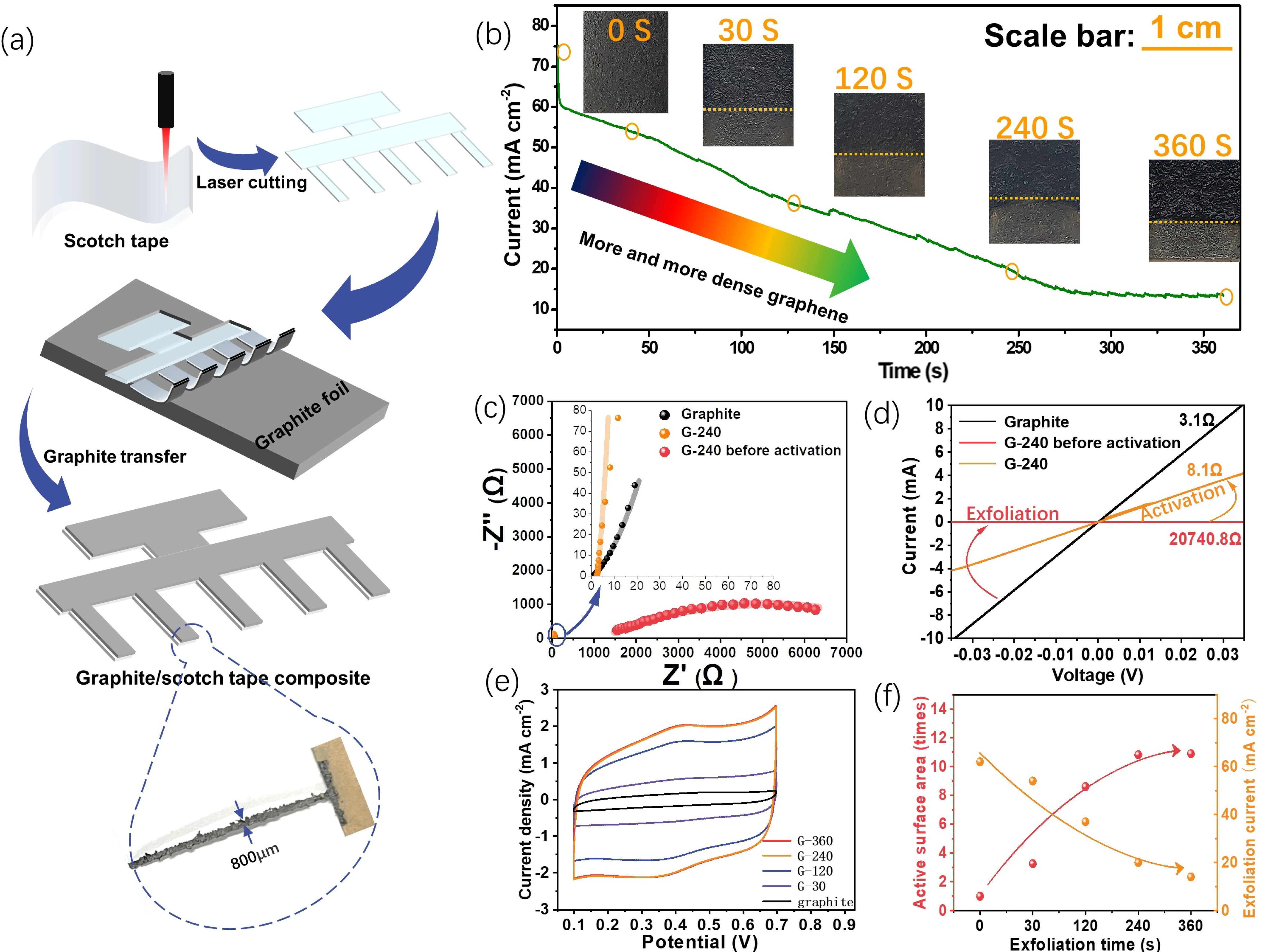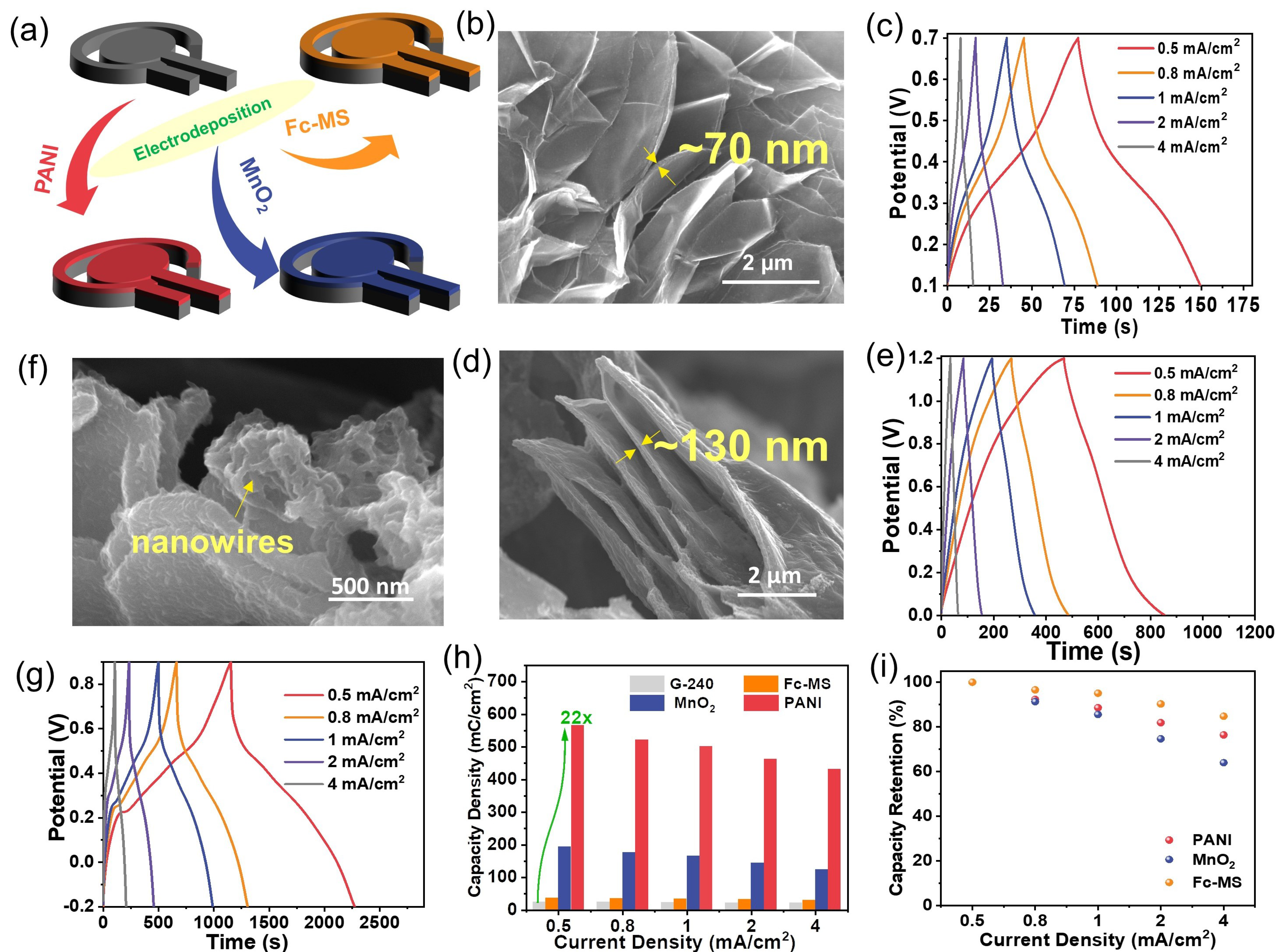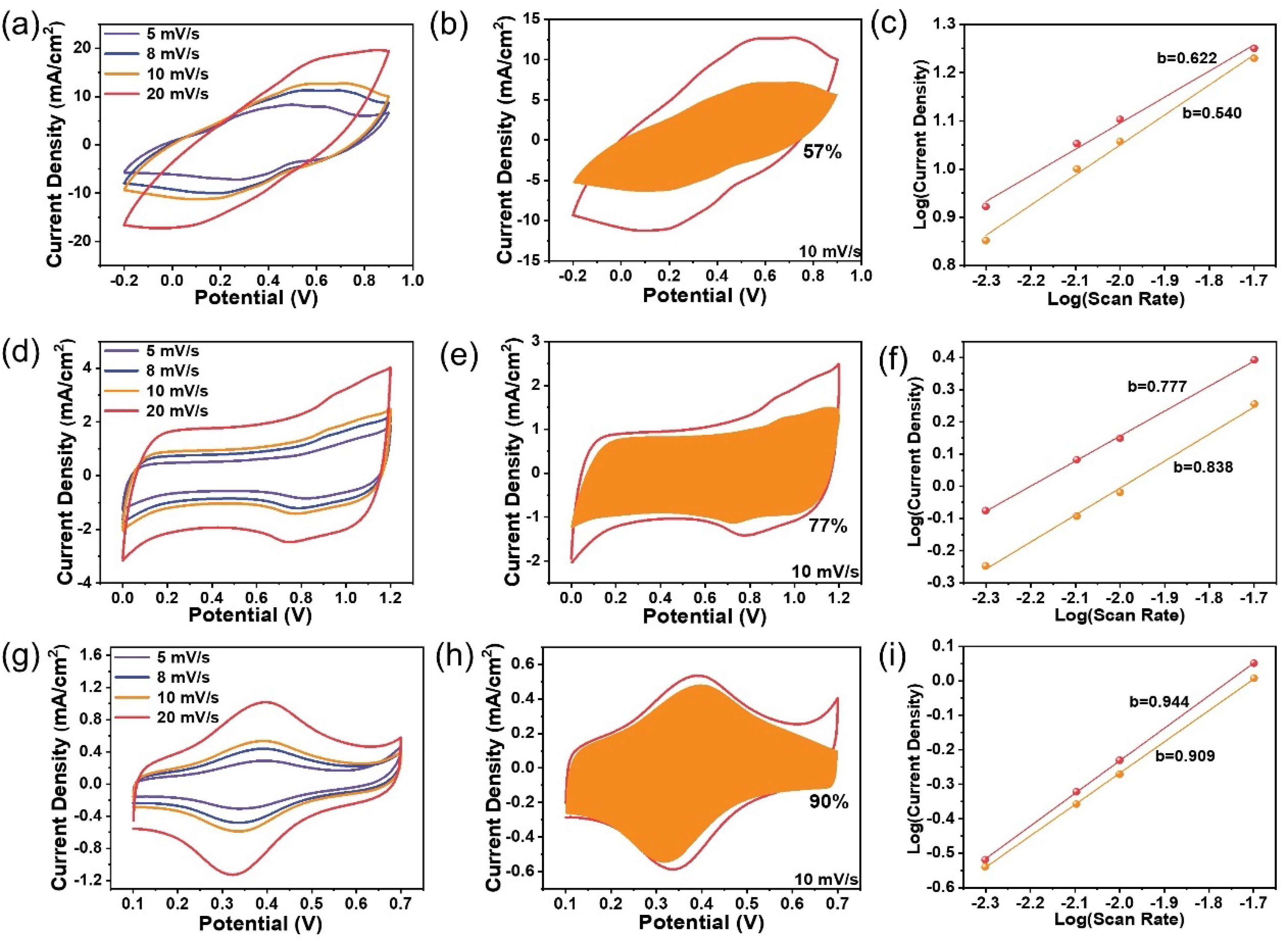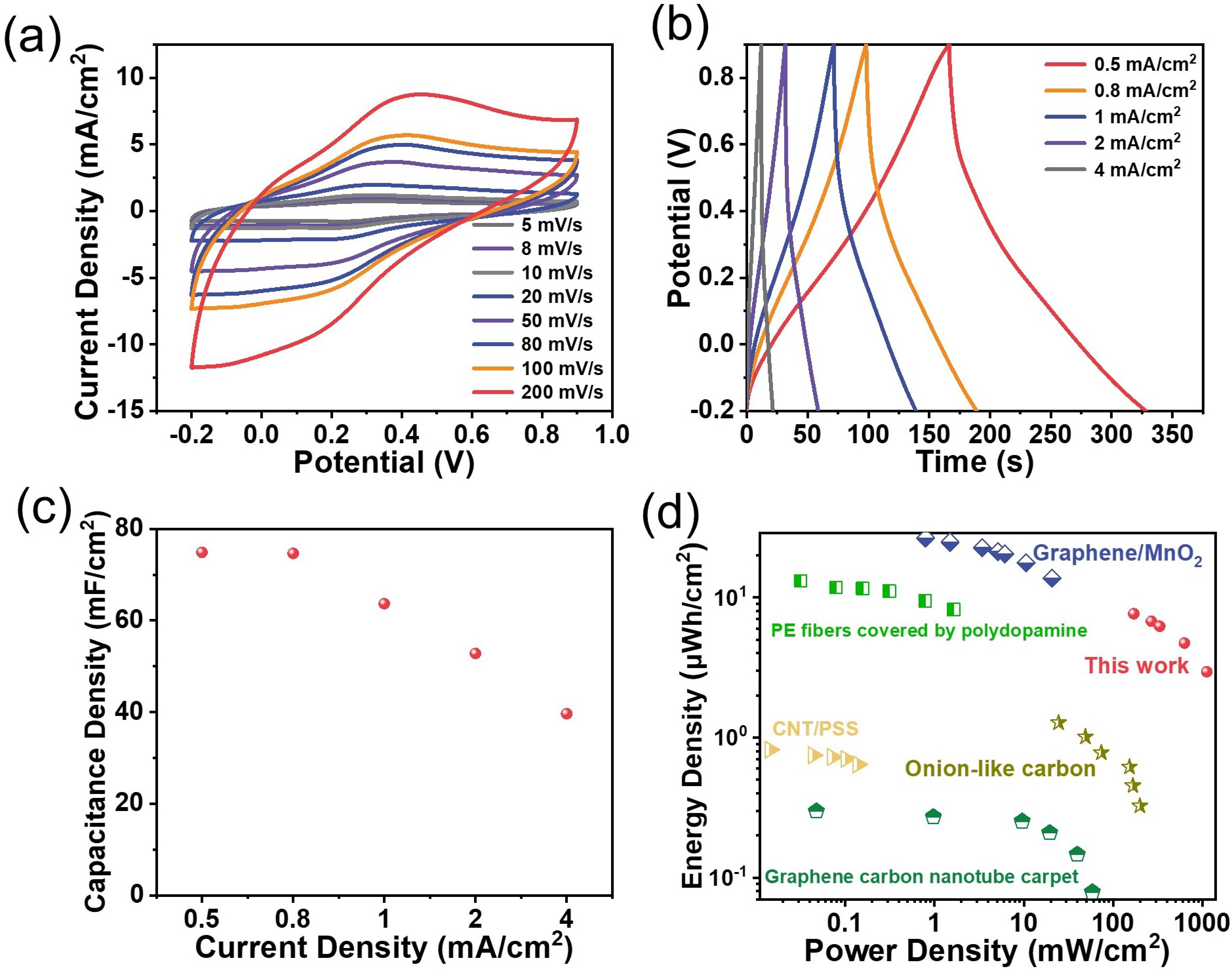Laser Cutting Coupled with Electro-Exfoliation to Prepare Versatile Planar Graphene Electrodes for Energy Storage
Abstract
1. Introduction
- the distance between the adjacent working and counter electrodes could be minimized to some extent through advanced patterning techniques, which could reduce the internal resistance of the devices and improve their power output [5];
- the monolayer nature of the in-plane structure could largely increase the volume energy density by decreasing the thickness of devices and also reduce short-circuit risks triggered by external forces;
- the simplified architecture also makes it easier for incorporation into electronic devices and even makes it suitable as a wearable power source when utilizing superiorly flexible supporting materials as substrates that can bear the long-term twisting and folding distortions.
2. Results and Discussion
2.1. Preparation of the Planar Graphite Electrodes
2.2. Physico-Chemical Characterization of the Planar Graphite Electrodes
2.3. Modification of the Planar Graphite Electrodes to Get Pseudocapacitive Materials
2.4. Evaluation of a Symmetrical Device
3. Materials and Methods
3.1. Reagents
3.2. Apparatus
3.3. Electrochemistry
3.4. Preparation of the Scotch Tape-Supported Graphene Samples (G-X, Where X Represents the Exfoliation Time)
3.5. Preparation of the Graphene-Supported Ferrocene-Functionalized Silica Thin Film Electrode (Fc-MS-G)
3.6. Preparation of the Graphene-Supported MnO2 Electrode (MnO2-G)
3.7. Preparation of the Graphene-Supported PANI Electrode (PANI-G)
4. Conclusions
Supplementary Materials
Author Contributions
Funding
Institutional Review Board Statement
Informed Consent Statement
Data Availability Statement
Acknowledgments
Conflicts of Interest
References
- Kyeremateng, N.A.; Brousse, T.; Pech, D. Microsupercapacitors as Miniaturized Energy-Storage Components for on-Chip Electronics. Nat. Nanotechnol. 2017, 12, 7–15. [Google Scholar] [CrossRef] [PubMed]
- He, H.; Fu, Y.; Zhao, T.; Gao, X.; Xing, L.; Zhang, Y.; Xue, X. All-Solid-State Flexible Self-Charging Power Cell Basing on Piezo-Electrolyte for Harvesting/Storing Body-Motion Energy and Powering Wearable Electronics. Nano Energy 2017, 39, 590–600. [Google Scholar] [CrossRef]
- Dubal, D.P.; Chodankar, N.R.; Kim, D.H.; Gomez-Romero, P. Towards Flexible Solid-State Supercapacitors for Smart and Wearable Electronics. Chem. Soc. Rev. 2018, 47, 2065–2129. [Google Scholar] [CrossRef]
- Zhao, C.; Liu, Y.; Beirne, S.; Razal, J.; Chen, J. Recent Development of Fabricating Flexible Micro-Supercapacitors for Wearable Devices. Adv. Mater. Technol. 2018, 3, 1800028. [Google Scholar] [CrossRef]
- Shao, Y.; Li, J.; Li, Y.; Wang, H.; Zhang, Q.; Kaner, R.B. Flexible Quasi-Solid-State Planar Micro-Supercapacitor Based on Cellular Graphene Films. Mater. Horiz. 2017, 4, 1145–1150. [Google Scholar] [CrossRef]
- Zhang, C.J.; Nicolosi, V. Graphene and MXene-Based Transparent Conductive Electrodes and Supercapacitors. Energy Storage Mater. 2018, 222, 11–20. [Google Scholar] [CrossRef]
- Kang, S.H.; Kim, I.G.; Kim, B.N.; Sul, J.H.; Kim, Y.S.; You, I.K. Facile Fabrication of Flexible In-Plane Graphene Micro-Supercapacitor via Flash Reduction. ETRI J. 2018, 40, 275–282. [Google Scholar] [CrossRef]
- Lamberti, A.; Clerici, F.; Fontana, M.; Scaltrito, L. A Highly Stretchable Supercapacitor Using Laser-Induced Graphene Electrodes onto Elastomeric Substrate. Adv. Energy Mater. 2016, 6, 1600050. [Google Scholar] [CrossRef]
- Pu, X.; Liu, M.; Li, L.; Han, S.; Li, X.; Jiang, C.; Du, C.; Luo, J.; Hu, W.; Wang, Z.L. Wearable Textile-Based In-Plane Microsupercapacitors. Adv. Energy Mater. 2016, 6, 1601254. [Google Scholar] [CrossRef]
- Liang, J.; Mondal, A.K.; Wang, D.W.; Iacopi, F. Graphene-Based Planar Microsupercapacitors: Recent Advances and Future Challenges. Adv. Mater. Technol. 2019, 4, 1800200. [Google Scholar] [CrossRef]
- Mohan, V.B.; Jayaraman, K.; Stamm, M.; Bhattacharyya, D. Physical and Chemical Mechanisms Affecting Electrical Conductivity in Reduced Graphene Oxide Films. Thin Solid Film. 2016, 616, 172–182. [Google Scholar] [CrossRef]
- Chen, Y.; Xu, B.; Xu, J.; Wen, J.; Hua, T.; Kan, C.W. Graphene-Based in-Planar Supercapacitors by a Novel Laser-Scribing, in-Situ Reduction and Transfer-Printed Method on Flexible Substrates. J. Power Sources 2019, 420, 82–87. [Google Scholar] [CrossRef]
- Gao, W.; Singh, N.; Song, L.; Liu, Z.; Reddy, A.L.M.; Ci, L.; Vajtai, R.; Zhang, Q.; Wei, B.; Ajayan, P.M. Direct Laser Writing of Micro-Supercapacitors on Hydrated Graphite Oxide Films. Nat. Nanotechnol. 2011, 6, 496–500. [Google Scholar] [CrossRef]
- Wu, Z.S.; Parvez, K.; Feng, X.; Müllen, K. Graphene-Based in-Plane Micro-Supercapacitors with High Power and Energy Densities. Nat. Commun. 2013, 4, 2487. [Google Scholar] [CrossRef] [PubMed]
- Li, L.; Secor, E.B.; Chen, K.S.; Zhu, J.; Liu, X.; Gao, T.Z.; Seo, J.W.T.; Zhao, Y.; Hersam, M.C. High-Performance Solid-State Supercapacitors and Microsupercapacitors Derived from Printable Graphene Inks. Adv. Energy Mater. 2016, 6, 1600909. [Google Scholar] [CrossRef]
- Yang, Y.; Hou, H.; Zou, G.; Shi, W.; Shuai, H.; Li, J.; Ji, X. Electrochemical Exfoliation of Graphene-like Two-Dimensional Nanomaterials. Nanoscale 2019, 11, 16–33. [Google Scholar] [CrossRef]
- Parvez, K.; Wu, Z.; Li, R.; Liu, X.; Graf, R. Exfoliation of Graphite into Graphene in Aqueous Solutions. J. Am. Chem. Soc. 2014, 136, 6083–6091. [Google Scholar] [CrossRef] [PubMed]
- Munuera, J.M.; Paredes, J.I.; Enterría, M.; Pagán, A.; Villar-Rodil, S.; Pereira, M.F.R.; Martins, J.I.; Figueiredo, J.L.; Cenis, J.L.; Martínez-Alonso, A.; et al. Electrochemical Exfoliation of Graphite in Aqueous Sodium Halide Electrolytes toward Low Oxygen Content Graphene for Energy and Environmental Applications. ACS Appl. Mater. Interfaces 2017, 9, 24085–24099. [Google Scholar] [CrossRef]
- Pei, S.; Wei, Q.; Huang, K.; Cheng, H.M.; Ren, W. Green Synthesis of Graphene Oxide by Seconds Timescale Water Electrolytic Oxidation. Nat. Commun. 2018, 9, 145. [Google Scholar] [CrossRef] [PubMed]
- Khakpour, I.; Baboukani, A.R.; Forouzanfar, S.; Allagui, A.; Wang, C. In-Situ Exfoliation and Integration of Vertically Aligned Graphene for High-Frequency Response on-Chip Microsupercapacitors. J. Power Sources 2021, 516, 230701. [Google Scholar] [CrossRef]
- Parvez, K.; Li, R.; Puniredd, S.R.; Hernandez, Y.; Hinkel, F.; Wang, S.; Feng, X.; Müllen, K. Electrochemically Exfoliated Graphene as Solution-Processable, Highly Conductive Electrodes for Organic Electronics. ACS Nano 2013, 7, 3598–3606. [Google Scholar] [CrossRef] [PubMed]
- Sutto, T.E.; Duncan, T.T.; Wong, T.C. X-Ray Diffraction Studies of Electrochemical Graphite Intercalation Compounds of Ionic Liquids. Electrochim. Acta 2009, 54, 5648–5655. [Google Scholar] [CrossRef]
- Pimenta, M.A.; Dresselhaus, G.; Dresselhaus, M.S.; Cançado, L.G.; Jorio, A.; Saito, R. Studying Disorder in Graphite-Based Systems by Raman Spectroscopy. Phys. Chem. Chem. Phys. 2007, 9, 1276–1290. [Google Scholar] [CrossRef] [PubMed]
- Ferrari, A.C. Raman Spectroscopy of Graphene and Graphite: Disorder, Electron-Phonon Coupling, Doping and Nonadiabatic Effects. Solid State Commun. 2007, 143, 47–57. [Google Scholar] [CrossRef]
- Yang, J.; Gunasekaran, S. Electrochemically Reduced Graphene Oxide Sheets for Use in High Performance Supercapacitors. Carbon N. Y. 2013, 51, 36–44. [Google Scholar] [CrossRef]
- Wang, J.; Vilà, N.; Walcarius, A. Electroactive Organically Modified Mesoporous Silicates on Graphene Oxide-Graphite 3D Architectures Operating with Electron-Hopping for High Rate Energy Storage. Electrochim. Acta 2021, 366, 13407. [Google Scholar] [CrossRef]
- Wang, J.; Vilà, N.; Walcarius, A. Redox-Active Vertically Aligned Mesoporous Silica Thin Films as Transparent Surfaces for Energy Storage Applications. ACS Appl. Mater. Interfaces 2020, 12, 24262–24270. [Google Scholar] [CrossRef] [PubMed]
- Lin, J.; Zhang, C.; Yan, Z.; Zhu, Y.; Peng, Z.; Hauge, R.H.; Natelson, D.; Tour, J.M. 3-Dimensional Graphene Carbon Nanotube Carpet-Based Microsupercapacitors With High Electrochemical Performance. Nano Lett. 2013, 13, 72–78. [Google Scholar] [CrossRef]
- Sim, H.J.; Choi, C.; Lee, D.Y.; Kim, H.; Yun, J.H.; Kim, J.M.; Kang, T.M.; Ovalle, R.; Baughman, R.H.; Kee, C.W.; et al. Biomolecule Based Fiber Supercapacitor for Implantable Device. Nano Energy 2018, 47, 385–392. [Google Scholar] [CrossRef]
- Pech, D.; Brunet, M.; Durou, H.; Huang, P.; Mochalin, V.; Gogotsi, Y.; Taberna, P.L.; Simon, P. Ultrahigh-Power Micrometre-Sized Supercapacitors Based on Onion-like Carbon. Nat. Nanotechnol. 2010, 5, 651–654. [Google Scholar] [CrossRef]
- Du, J.; Wang, Z.; Yu, J.; Ullah, S.; Yang, B.; Li, C.; Zhao, N.; Fei, B.; Zhu, C.; Xu, J. Ultrahigh-Strength Ultrahigh Molecular Weight Polyethylene (UHMWPE)-Based Fiber Electrode for High Performance Flexible Supercapacitors. Adv. Funct. Mater. 2018, 28, 1707351–1707360. [Google Scholar] [CrossRef]
- El-Kady, M.F.; Ihns, M.; Li, M.; Hwang, J.Y.; Mousavi, M.F.; Chaney, L.; Lech, A.T.; Kaner, R.B. Engineering Three-Dimensional Hybrid Supercapacitors and Microsupercapacitors for High-Performance Integrated Energy Storage. Proc. Natl. Acad. Sci. USA 2015, 112, 4233–4238. [Google Scholar] [CrossRef]
- Ullah, W.; Herzog, G.; Vilà, N.; Walcarius, A. Polyaniline Nanowire Arrays Generated Through Oriented Mesoporous Silica Films: Effect of Pore Size and Spectroelectrochemical Response. Faraday Discuss. 2022, 233, 77–99. [Google Scholar] [CrossRef] [PubMed]
- Vilà, N.; Ghanbaja, J.; Aubert, E.; Walcarius, A. Electrochemically Assisted Generation of Highly Ordered Azide-Functionalized Mesoporous Silica for Oriented Hybrid Films. Angew. Chem. Int. Ed. 2014, 53, 2945–2950. [Google Scholar] [CrossRef] [PubMed]





Disclaimer/Publisher’s Note: The statements, opinions and data contained in all publications are solely those of the individual author(s) and contributor(s) and not of MDPI and/or the editor(s). MDPI and/or the editor(s) disclaim responsibility for any injury to people or property resulting from any ideas, methods, instructions or products referred to in the content. |
© 2023 by the authors. Licensee MDPI, Basel, Switzerland. This article is an open access article distributed under the terms and conditions of the Creative Commons Attribution (CC BY) license (https://creativecommons.org/licenses/by/4.0/).
Share and Cite
Wang, J.; Yang, T.; Vilà, N.; Walcarius, A. Laser Cutting Coupled with Electro-Exfoliation to Prepare Versatile Planar Graphene Electrodes for Energy Storage. Int. J. Mol. Sci. 2023, 24, 5599. https://doi.org/10.3390/ijms24065599
Wang J, Yang T, Vilà N, Walcarius A. Laser Cutting Coupled with Electro-Exfoliation to Prepare Versatile Planar Graphene Electrodes for Energy Storage. International Journal of Molecular Sciences. 2023; 24(6):5599. https://doi.org/10.3390/ijms24065599
Chicago/Turabian StyleWang, Jianren, Tianshuo Yang, Neus Vilà, and Alain Walcarius. 2023. "Laser Cutting Coupled with Electro-Exfoliation to Prepare Versatile Planar Graphene Electrodes for Energy Storage" International Journal of Molecular Sciences 24, no. 6: 5599. https://doi.org/10.3390/ijms24065599
APA StyleWang, J., Yang, T., Vilà, N., & Walcarius, A. (2023). Laser Cutting Coupled with Electro-Exfoliation to Prepare Versatile Planar Graphene Electrodes for Energy Storage. International Journal of Molecular Sciences, 24(6), 5599. https://doi.org/10.3390/ijms24065599






